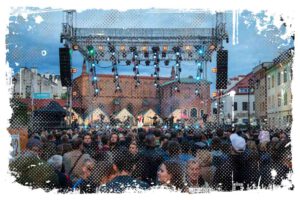Krakow – a city that was once the proud capital of Poland, bustling with knights, scholars, and merchants who flocked to the city. These guests found solace for the night not just in dormitories, but also in the inns and bars that dotted Kraków. Let me say, the city was teeming with such establishments, making it a bit of a challenge today to pinpoint which one sprang up first.

- If you’re looking at the places you can have a drink in Krakow, you should definitely check out this article: The Best Bars and Pubs in Kraków – Your Ultimate Guide
What Were The Oldest Bars in Kraków?
The hot spot in medieval Krakow, I can tell, was none other than the Piwnica Świdnicka. Nestled in the Town Hall's basement on the Main Market Square, it was famous for its superb beer brought in from Świdnicka. Another popular spot was the Strasza Inn at Floriańska 28.

Being there, you need to know that the city authorities didn’t let these places run wild. They kept a strict eye on them. On Sundays, patrons could only be served after mass. And when night fell on weekdays, taverns could only accommodate „takeaway” orders.
If you want a glimpse into the past, imagine Krakow in 1850, with a population of just 40,000. According to Jan Adamczewski, the city had 17 restaurants, 140 taverns, and 52 soup kitchens.
- Here you can find more Google pictures and location of the Ratuszowa restaurant in Krakow.
I think it’s fascinating to see how these eateries were organized. At the top were hotel restaurants and barracks, which operated independently. Then came the lower-tier establishments – distilleries, or hams, followed by soup kitchens, and finally the mobile farins. Of these, two farins were particularly popular – one at St. Florian’s Gate and the other connecting the Small Market Square to St. Mary’s Square. The midday bugle call from St. Mary’s Tower was like a dinner bell, signaling it was time to serve meals.
A Turning Point in Krakow’s Gastronomic Journey
The game-changer in the city’s food scene, I am convinced, was the opening of a restaurant in the „Pod Biała Różą” hotel at Stradom 13, masterminded by Józef de Paulis. I believe it fueled competition among local owners as they strove to win over customers.
↳ Make sure to read my guide to the most amazing places to stay in Kraków:
How to Find Best Place to Stay in Krakow Old Town – Your Guide
It’s worth mentioning that it was this hotel – not the „Pod Różą” at 14 Floriańska Street – where the renowned French writer Honoré de Balzac stayed in May 1850. The latter hotel, then known as the „Russian” or „Hotel de Russie,” was named in honor of Tsar Alexander I and Grand Duke Konstanty who stayed there in 1805. After the uprising in 1863, the hotel’s name changed to „Pod Biała Różą”.
Before the First World War, the Market Square alone boasted more than ten alcohol outlets, and the Small Market Square added another five. But don’t get the wrong impression – as Jan Adamczewski quoted from Franciszek Klein, despite the plethora of pubs and taverns, there were no drunks on the streets. Now, isn’t that a fun piece of trivia?
- I think you should read more about the main Square in Krakow here: A Guide to Krakow’s UNESCO Old Town Sites And Many More
A Culinary Walk Down Memory Lane in Krakow
Fast forward a few years and we find the dining scene in Krakow flourishing with distinctive establishments. The restaurant by Kosch and Wybiral, situated where „Balaton” restaurant stands today, was one of the most famous of the time. If you need a go-to place for the best maczanki, this was it!
- You can read more about the best food you can eat in Krakow in this article: Culinary Paradise – Best Traditional Food You Can Eat In Kraków
For a top-notch marinated herring, Mandelbaum’s was your place, and for a grand breakfast – sandwiches stacked high with a pyramid of delicacies – Antoni Hawełka’s place in Krzysztofory was the spot to be.
Being there, you need to know that this wasn’t just a place to grab a bite. From 1883 onwards, the Jagiellonian University professors – the likes of W. Creizenach, K. Morawski, Wł. Natanson, K. Kostanecki, J. Mycielski – gathered here every two weeks. This place was also frequented by renowned journalist Rudolf Starzewski and famed writer Henryk Sienkiewicz.
The legacy of this place was continued by Franciszek Macharski (1852 – 1934), who in 1913 relocated it to the Spiski Palace, where it still operates. This place is now known as „Hawełka”. This hotspot, open until late at night, attracted artists, writers, and journalists alike. Actors and spectatrs often congregated here after evening performances.
- You should also read the articles about the oldest restaurants in Krakow: Unveiling Krakow’s Oldest Restaurants – Feasting on Tradition
Art and Gastronomy – An Unlikely Pairing
„Hawełka” wasn’t just a place for delicious food. Its banquet hall, later named Tetmajerowska, showcased a decorative frieze painted by Włodzimierz Tetmajer in the early 20th century. This piece of art illustrated the legend of Master Twardowski. Let me say, „Hawełka” was ahead of its time. It was one of the first establishments in Krakow to have a telephone installed in January 1900, enhancing customer convenience.

Krakow’s hotel scene wasn’t left behind either. Excellent restaurants could be found at the „U Pollera” hotel, „Grand”, and the „Francuski”. Thorna’s restaurant on Krakowska Street, Drobner’s on Szczepański Square, and Feilguta’s on Szczepańska Street were other worthy contendrs.
If you were looking for a unique experience, „U Wentzla” at Rynek Główny 1 was the place to be. Located in a building known as „Under the Picture” due to a painting of the Virgin Mary on its facade, it was believed to be one of the best places to eat in Krakow, as indicated by a popular saying at the time.
The Legendary Feast at Wierzynek

Krakow’s most famous restaurant, „Wierzynek„, didn’t open its doors until 1945, at 16 Rynek Główny. According to legend, it was in this very building that a grand feast took place in 1364. Mikołaj Wierzynek hosted this royal feast in honor of Casimir the Great’s distinguished guests, including the Holy Roman Emperor, and the monarchs of Hungary, Denmark, Cyprus, Jerusalem, and Armenia.
Chronicles by Jan Długosz record the opulent feast, which saw the guests presented with golden tableware. Now that, I know, was truly a feast to remember!
Reference:
- https://pl.wikipedia.org/wiki/Piwnica_%C5%9Awidnicka_w_Krakowie



